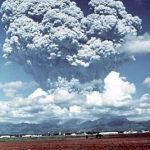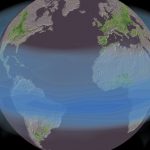Engineering Earth’s climate might quell global warming, but it could come with a cost
When Mount Pinatubo violently erupted in 1991, the volcano blasted millions of tons of gas well over 20 miles into Earth’s atmosphere. After condensing into little droplets, the particles reflected sunlight back into space and cooled the planet by about 1 degree Fahrenheit for over a year.
Nearly three decades later, some scientists wonder if humans could effectively do the same thing — by using blimps, rockets, or planes — in the name of combating the increasingly ruinous consequences of global warming.
This geoengineering concept, however, may carry some unintended consequences — particularly when it comes to the world’s future food supply.
In a study published Wednesday in the journal Nature, researchers examined how massive volcanic eruptions like Pinatubo’s affected the growth of crops. The scientists found that while edible plants grow much better when it’s cooler, the diminished sunlight stymied the growth of wheat, rice, corn, and soy.
In short, artificially cooling the planet might not save vast croplands imperiled by accelerating, human-caused climate change.
“If we think of geoengineering as an experimental surgery, our findings suggest that the side effects of the treatment are just as bad as the original disease,” Jonathan Proctor, a study coauthor who researches the potential impacts of geoengineering on agriculture at the University of California, Berkeley, said in a press call.
There are different ideas of how to geoengineer, or intervene in, Earth’s climate. And one of the most studied concepts is solar geoengineering. That idea hinges on reflecting sunlight into space, keeping the Earth cooler.
The most realistic way to accomplish this is to try to mimic the effects of volcanoes and repeatedly send reflective particles, or gases that become reflective particles, into the high atmosphere.
However, the science around solar geoengineering — and how it might affect the planet — is not nearly settled.
Engineering our climate is a largely conceptual, almost science fiction-like idea, at least for now.
“Different people have talked about this technology as if it’s something of a last resort,” Solomon Hsiang, also a study coauthor, said in an interview. “I think we really don’t know how risky it might be.”
To better understand the risk of intentionally reflecting sunlight back into space — which reduces the amount of heat that enters Earth — Hsiang’s team looked at wheat, rice, maize, and soy production in over 100 countries between 1979 and 2009. Then, they used satellite measurements of the reflective particles spewed from volcanoes, known as sulfate aerosols, to determine that the blocked sunlight canceled out any benefits crops receive from growing in cooler conditions.
That said, the way volcanoes cool the planet are quite different than how human-engineered cooling would likely impact the climate, said David Keith, a physicist at Harvard University’s Solar Geoengineering Research Program.
“Yet, this study implies in its introduction and conclusion that volcanic eruptions are more or less synonymous with geoengineering. That’s false,” said Keith, who wasn’t involved with the new study.
For one, unlike a volcanic eruption, geoengineering would involve a continuous loading of aerosols into the atmosphere, which will have substantially different climatic consequences, Keith added.
Volcanoes cool the land much more quickly than the oceans, leading to a global temperature imbalance that has significant effects on rainfall. Secondly, volcanic eruptions like Pinatubo’s often don’t spread reflective particles evenly around the globe, so the dimming might be concentrated in one hemisphere, which brings other shifts to global weather and rainfall.
“Bottom line: Solar geoengineering will produce a different climate response than a volcano making it difficult to use this volcanic data to directly assess the agricultural impacts of possible solar geoengineering,” said Keith.
Hsiang makes clear that they’re not in support of or opposed to geoengineering, but that they’re attempting to reveal the realities of sending clouds of reflective particles into the upper atmosphere.
Geoengineering, emphasized Hsiang, is by no means the best, nor easiest, solution to combating a global disruption of Earth’s climate, which has been stoked by human emissions of potent greenhouse gases like carbon dioxide into the atmosphere.
“The surest way to deal with that [climate change] is to mitigate greenhouse gas emissions — that’s a matter of simple science,” said Hsiang.
Geoengineered sulfate particles would be loaded miles up in the atmosphere, well above the clouds.
Geoengineered sulfate particles would be loaded miles up in the atmosphere, well above the clouds.
This largely means generating electricity with renewables, like solar, wind, and geothermal energy, rather than fossil fuels, and driving vehicles that don’t run on gasoline.
“I would say these results suggest that both warming and geoengineering pose risks to the global food supply,” Nathan Mueller, an assistant professor of Earth System Science at the University of California, Irvine who had no role in the study, said in an interview.
“I would say that the best way to ensure a food secure future is to invest in reducing emissions and supporting farmers as they adapt to a warming climate.”
The climate is already loaded with the highest concentration of carbon dioxide than at any time in the last 800,000 years, meaning that Earth’s climate is already locked in for future warming, well beyond this century.
This is why solar geoengineering might one day be seriously considered by governments, even as renewables become more prevalent, and solar panels are fitted on millions of rooftops.
“The intuition we think about is that it [geoengineering] is a parachute,” said Hsiang, referencing geoengineering as a last-resort option. “You want to understand that you have a parachute, and know you can use it.”
IMAGES:
IMAGE: NASA
An animation of aerosol particles from Mount Pinatubo shrouding portions of Earth between June 1991 and September 1993. JONATHAN PROCTOR AND SOLOMON HSIANG
Mount Pinatubo’s ash cloud, in 1991.IMAGE: USGS
A graphic showing volcanic particles shrouding the Earth after the violent eruption of Mount Pinatubo in 1991.IMAGE: JONATHAN PROCTOR
For more on this story go to: https://mashable.com/2018/08/08/geoengineering-sunlight-climate-change/?utm_source=feedburner&utm_medium=feed&utm_campaign=Feed%3A+Mashable+%28Mashable%29#fiqQ9YusVsqB









